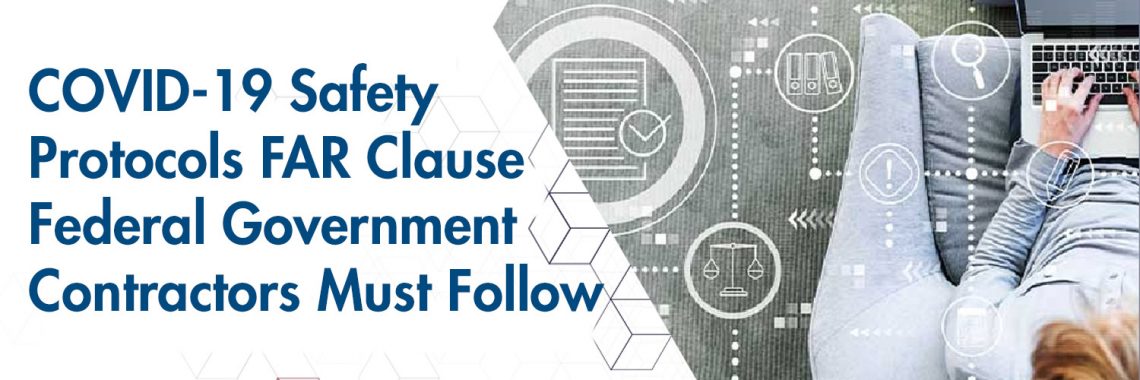
At Biden’s directive, the FAR now has a COVID-19 safety protocol clause. The new
FAR clause requires, among other things, that contractors and subcontractors, implement COVID-19 safety protocols – to include a mandate to get employees vaccinated.
Read on for general information on the contracts and subcontracts that will be subject to the clause and for a summary of the requirements.
Remember – read your contracts, including that long list of clauses – to know what applies to yourcompany.
How did the FAR clause mandating vaccines and other COVID-19 safety protocols comeabout?
September 9, 2021 President Biden issued Executive Order 14042 directing federal agencies toimplement regulations requiring federal government contractors and subcontractors to follow COVID-19 safety protocols.
The U.S. Government Safer Federal Workforce Task Force issued COVID-19 safety protocolguidance, to include FAQs that, along with CDC requirements, define what contractors andsubcontractors must do to comply with the Executive Order.
September 30, 2021, the U.S. Office of Management and Budget (OMB) issued a memorandum to the Defense and Civilian Acquisition Regulation Councils directing them to issue “deviations” (temporary regulations) requiring contractors and subcontractors to comply with the EO and the Task Force mandates. The deviations will remain in place while the FAR Council works to draft permanent acquisition regulations on required COVID-19 safety protocols.
What does the draft FAR clause say?
In its memo, OMB provided a draft FAR clause, 52.223-99, that agencies could
use. Unfortunately, the clause says nothing more than contractors must comply with the Safer Federal Workforce Task Force guidance and FAQ’s to include complying with any amendments the Task Force may issue during contract performance. It also requires prime contractors to flow the clause down tosubcontractors at all tiers.
What are the required safety protocols referenced in the FAR Clause?
In summary the Task Force Guidance requires:
- All contractor and subcontractor employees be vaccinated against COVID-19 by December 8, 2021;
- Contractor and subcontractor employees and visitors to wear masks as directed by the CDC which generally requires masks for persons not fully vaccinated; masks in healthcare, transportation, correctional, or detention facilities and in schools; masks if community transmissions in the areaare high;
- Developing protocols for physical distancing;
- Allowing for accommodations and exemptions to these requirements for employees or visitors withdisabilities, medical conditions, and sincerely held religious beliefs;
- Designating a person or team to coordinate the implementation of and compliance with the requiredsafety protocols;
- Posting visible signs informing employees and visitors of safety protocols for fully vaccinatedand unvaccinated individuals;
- Advising employees on convenient locations for vaccines;
- Following Task Force Guidance and FAR clauses if state or local laws conflict with the guidanceor clause;
- Checking, at least weekly, the CDC COVID-19 Data Tracker County View website forcommunity transmission information for locations where the contractor has a workplace andadapt protocols as needed;
- Develop protocols for assuring visitors to the contractor workplace are vaccinated orappropriately masked;
- Documenting compliance – to include that employees are vaccinated or exempt from
Do the requirements apply to ALL employees?
Generally, unless an employee has an accommodation or an exception, the requirements apply. Therequirements apply:
- Whether employees or visitors are working indoors or outdoors;
- To employees working remotely, even if working at their own home;
- To all employees performing work “in connection with” a government contract or subcontract – this includes those engaged in actually working on the contract as well as those in support of contract performance but not directly working on the contract such as human resources, finance, or
- To employees working in contractor facilities, buildings or floors that do not perform government contracts unless a contractor can “affirmatively determine” that those employees will NOT come in contact with employees working in connection with a
What contracts and subcontracts are covered?
- Procurement contracts and subcontracts for services, construction, or leases in real property;
- Contracts and subcontracts covered by the Service Contract Act;
- Contracts and subcontracts for concessions; or
- Contracts and subcontracts in connection with Federal property or lands;
- Contracts and subcontracts related to offering services to federal government employees, their dependents, or to the general public.
What contracts and subcontracts are not covered?
- Contracts or subcontracts with Indian Tribes;
- Contracts or subcontracts that are equal to or less than the simplified acquisition threshold, which is currently $250,000;
- Contracts or subcontracts performed outside of the United States;
- Subcontracts solely for products or
Are prime contracts for products or supplies covered by the clause?
A careful read of the EO leaves one wondering if contracts for products, supplies, for manufacturing or for services and products/supplies are covered or not. The EO specifically excludes subcontracts that are solely for products; yet does not exclude prime contracts for products. The EO specifically includescontracts and subcontracts for services and for construction yet does not mention contracts or subcontracts for supplies, products or manufacturing.
The draft FAR clause does not resolve whether prime contracts for products, supplies or manufacturing are covered since it simply refers to the EO and the Task Force guidance without additional clarification.
What is clear though is that guidance and the DoD implementation of its COVID-19 safety clause encourage contracting officer to include the clause in all contracts and subcontracts. So, contractorsshould not be surprised to find CO’s deciding to include the clause in all contracts.
Are small business required to comply?
Yes. The clause is directed to the type of contract not to the size of the contractor or subcontractor. So, regardless of size, if a prime contractor or subcontractor has a contract that is covered, even if they are asmall business, they must comply.
Do the clauses flow down to subcontractors?
Prime contractors with contracts subject to the COVID-19 FAR clauses are required to flow the clause to subcontractors at all tiers. According to the Task Force FAQ’s, once the clause is flowed down to subcontractors, unless the prime contractor has “credible evidence” that a subcontractor is not complying with the clause, the prime contractor can assume that the subcontractor is complying. This suggests that primes need not, at this point, audit subcontractors for compliance.
When will the clause go into effect?
The COVID-19 safety FAR clauses will be included in:
- Contracts or task orders issued under an indefinite delivery contract awarded on or after November 14, 2021;
- Solicitations issued on or after October 15, 2021, and in the contracts or task orders awarded inresponse to these solicitations;
- Extensions or renewals of existing contracts and task orders awarded on or after October 15;
- Options on existing contracts and task orders exercised on or after October 15,
Be alert however, because contracting officers may seek to amend existing contracts or existing task orders to include the clause. In fact, DoD’s temporary regulation specifically allows for amendment, if its bilateral.
Are grants and cooperative agreements covered?
The EO does not include directives to have the Uniform Guidance, which regulates grants andcooperative agreements, updated with the safety protocols. So, as of today, grants and cooperative agreements will not be updated or issued with a COVID-19 safety protocol clause. However, grant and cooperative agreement recipients should anticipate that the Uniform Guidance will at some point beupdated to include the requirements.
Are the costs of compliance allowable costs?
Costs of implementing these requirements will likely be allowable as an indirect cost of performing the contract or subcontract. DoD, in its version of the COVID-19 safety clause, since it allows contracting officers to modify existing contracts through a bilateral modification, provides that contractors maynegotiate with DoD for increased costs. (DFAR 252.223-7999.)
What if a contractor or subcontractor does not comply?
For instances of non-compliance, the government will likely be able to deploy its “usual” punishments: terminate the contract; claw back payment; pursue False Claims Act remedies of fines and/or criminalpenalties; and suspension or debarment.
Recommendations for Compliance
- Advise executives and leadership of the new regulations and discuss how therequirements will be executed;
- Assign an employee or team responsibility for developing strategic compliancerequirements as well as for executing tactical requirements;
- Check CDC COVID-19 and Safer Federal Workforce Task Force websites weekly for updated requirements;
- Develop and execute a training and communication campaign for employees on therequirements and your company’s processes for compliance;
- Review RFP, solicitations, contracts and subcontracts to determine if the new clause is included;
- Consult with employment legal counsel and work with human resources to develop policies and procedures for evaluating and allowing requests for religious or medical accommodations orexceptions;
- Determine what documents (hardcopy or electronic) will prove vaccination and how these documents will be maintained and secured. Some examples of proof, according to the guidanceare:
- A record of immunization from a health care provider or pharmacy
- A copy of the COVID-19 Vaccination Record Card (CDC Form MLS-319813_r, published on September 3, 2020)
- A copy of medical records documenting the vaccination
- A copy of immunization records from a public health or State immunization information system
- A copy of any other official documentation verifying vaccination that includes the vaccine name, date(s) administered, health care professional or clinics that administered thevaccine administering vaccine
- Track and document which employees have been vaccinated;
- Track and document the employees with accommodations and exceptions;
- Develop and maintain privacy protocols for information related to employee vaccines,accommodations and exceptions since this is medical information;
- Assess which subcontracts may need to include the requirements, update subcontracts as neededwith the new clause;
- Even if contracts and subcontracts are for supplies, for manufacturing, for a combination of services and supplies, or below the simplified acquisition threshold, be alert for the clause in newcontracts or for modifications to existing contracts;
- Assess and document the costs of compliance to determine if the costs will impact indirectrates or should be included in indirect or overhead costs;
- Develop procedures in the event there is “credible evidence” a subcontractor is not complyingwith the safety protocols if they are required to do

